You may also like
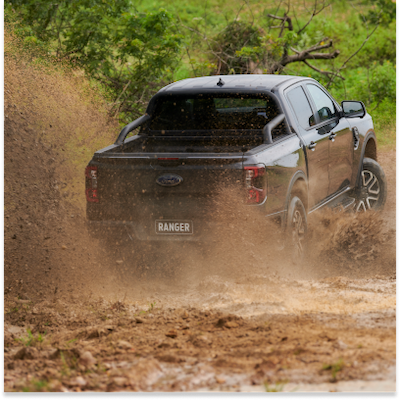
Get up and go:
Off-roading
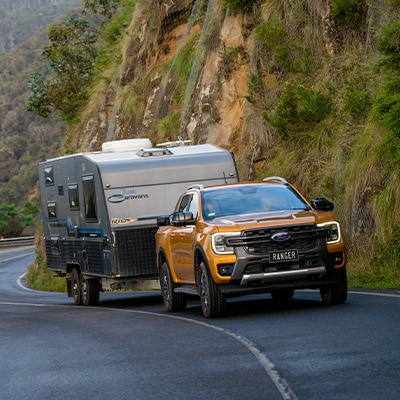
Get up and go:
Towing guide
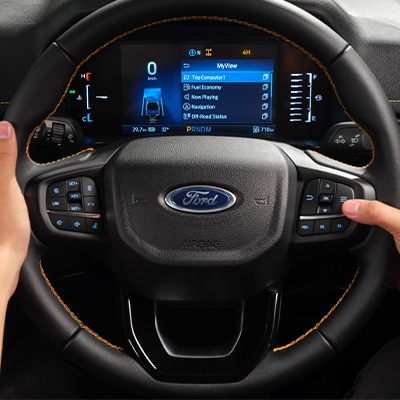
Driving in bad weather not only requires common sense, but it also calls upon driving techniques and knowledge seldom tested in good conditions. Bad weather doesn’t always mean rain. If you’ve ever driven in fog, or bright sun then you’ll know how testing these conditions can be as well.
Ranger has been equipped with a raft of features to ensure you don’t have to stop what you’re doing no matter the weather. Here’s everything you need to know about how Ranger helps you get from A to B in various weather conditions, as well as a few handy hints to make driving in extreme weather more enjoyable.
Heavy rain can reduce visibility dramatically, so make sure you get into the habit of regularly checking your vehicle’s windscreen wipers. If they feel brittle or cracked to the touch, then have them replaced immediately, and never run your wipers on a dry windscreen or you could scratch the windscreen. Some Ranger variants have rain-sensing windscreen wipers1 which can automatically switch the wiper action between intermittent for light rain to fast for heavy downpours. If the vehicle is equipped with rain sensing wipers, they will operate by default when the wiper stalk is in the intermittent mode position.
You can also manually adjust the sensitivity (high or low) of the rain-sensing wipers via a toggle on the back of the windscreen wiper stalk.
From the Sync screen you can toggle courtesy wipe and rain sensing wipers on or off.
If you should want to de-activate rain-sensing wipers:
Your vehicle’s tyres are its only contact with the road, so making sure they’re inflated to the correct pressure and have enough tread is vital. Some Ranger variants have a Tyre Pressure Monitoring System2 which will alert you if it detects any one of your vehicle’s tyres are underinflated. A tyre pressure placard is located on the driver’s side B-pillar and contains information on the recommended front and rear tyre pressures.
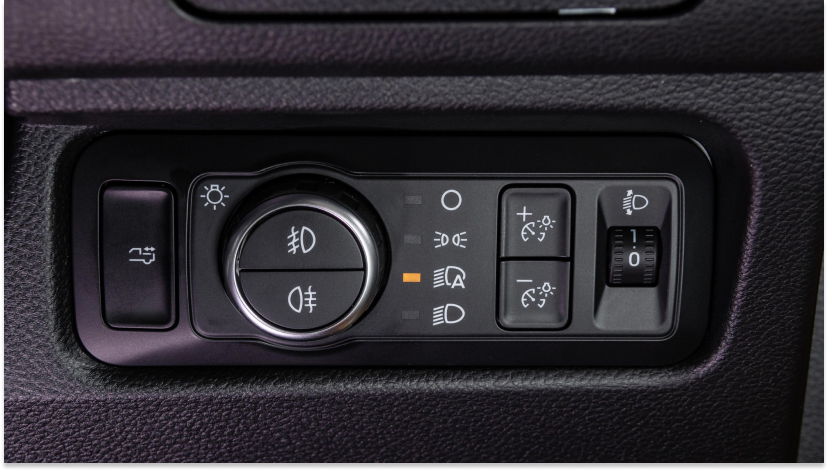
Auto headlamps are now standard on all Ranger variants. This feature ensures headlamps will switch on as the outside light begins to fade and/or when the windscreen wipers activate detecting rain. Auto headlamps are standard on all Ranger. The illuminated “A” symbol on the light switch indicates that auto head lamps are on.
Wet weather can cause your windscreen to fog up while cold weather could cause a thin film of ice to form on your windscreen. To clear fog or ice, simply press the Max Defrost button which is located on the climate control panel beneath the touch screen. Heated rear window will also be activated by selecting Max Defrost.
To keep the windows from fogging up, the system disables recirculated air, switches the temperatures to its highest setting and the blower motor adjusts to the highest speed.

It’s important to keep your front and rear windscreens clean. A dirty windscreen at night can cause light to glare into the cabin and make it difficult to see down the road. Similarly, on a sunny day, a dirty windscreen can impair your vision. You can use the windscreen washer function and then wipers to clean your windscreen or, before leaving home you could spray and wipe the inside and out of all your windows. Ensure to lift the wipers while cleaning the outside of the front windshield. As part of the Ranger’s modern styling, wipers arms are hidden below the hood line. To lift the wipers for cleaning, activate wipers, when in mid wipe position turn the engine off. This leaves the wipers accessible from the outside of the vehicle. You can now move them out of the way. Please be sure to return to the down position before switching the vehicle on again. The wipers will return to home position automatically when the vehicle is powered.
The windscreen washer function does more than just clean the windscreen. If your Ranger is equipped with the 360-degree camera3,5 be sure to keep the camera lenses clean. Your view ahead relies on the forward facing camera. You can access this camera view via the Off-Road screen so picking your path is easier.
Driving in wet weather will take longer than driving the same route when it’s dry. The road ahead could be flooded or jammed with slow-moving traffic, so rather than trying to rush, give yourself some extra time and remember that everyone’s in the same boat as you. Just as important as giving yourself some more time to reach your destination, make sure your vehicle is topped up with fuel.
Common sense tells us that when driving some conditions reduce driver visibility. Night time driving can result in reduced visibility. Pedestrians can sometimes make hurried and unplanned road crossings in front of an obstructed vehicle. Ranger’s Pre-Collision Assist4,5 function makes use of the forward-facing camera and sensors to detect vehicles, cyclists and pedestrians and provides multiple levels of assistance to help avoid a collision. If your vehicle is rapidly approaching potential hazards the system provides the following levels of functionality: Alert, Brake Support, Automatic Emergency Braking. Pedestrian detection system is active at speeds between the speeds of 4-80km/h. To ensure the system is enabled, use the touchscreen:
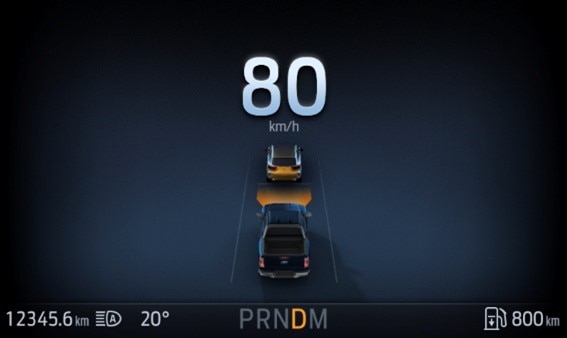
When the roads are wet and slippery it’s vital that you slow down and give yourself more room on the road for braking (in normal driving the three-second rule applies, driving in wet weather conditions should see that gap stretch to almost 10-seconds). While Ranger features distance indication5 which displays the gap between you and the vehicle in front of you, commonsense should be applied – treat rain as a reminder that you should slow down and increase the distance between you and the vehicle in front of you.
Vehicle Speed | System Sensitivity | Distance Indicator Colour | Distance Gap | Time Gap |
100 km/h | Normal | Blue | Greater than 25m | 0.9 seconds or greater |
Yellow | 17 – 25m | 0.6 – 0.9 seconds | ||
Red | Less than 17m | 0.6 seconds or less |
Depending on where you live and where you may find yourself on adventures, it can be possible to be in a bush fire prone area. Avoid driving in heavy smoke as this reduces visibility for the driver.
A puddle of water can hide a deep pothole, a manhole or even a sinkhole. Furthermore, if there is enough water on the road, car tyres might not be able to clear enough water from the tread to maintain traction or contact with the road and then aquaplane, lifting off the ground, driving on a layer of water.
Don’t underestimate the dangers of flooded roads. Don’t attempt to drive through a flooded road that you couldn’t walk through (15cm of fast-flowing water is enough to knock a person off their feet) and be aware that water hides dips in the road. Worse still, there may be no road at all under the water. Flooding can wash away the entire road surface and a significant amount of ground beneath. Never attempt to drive across a flooded river.
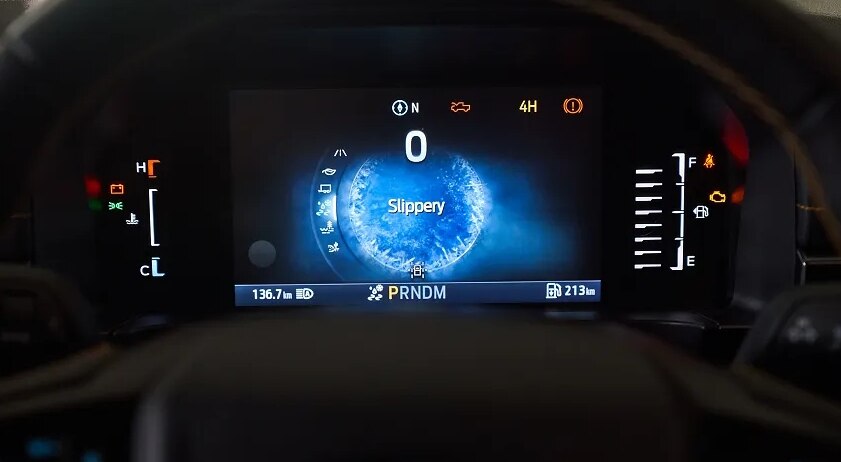
For less-than-ideal conditions such as hard-packed snow, loose gravel or ice you could use Slippery mode5,6. This mode can be used for crossing terrain where a firm surface is covered with slippery material. Slippery mode lowers throttle response and optimises shifting for slippery surfaces. To change your vehicle’s drive mode, simply turn the outer ring of the drive mode dial on the centre console.
If you can no longer see the edges of the road or you can’t clearly see other vehicles at a safe distance, then stop and reassess your situation. Make sure you move off to the side of the road, so long as it’s safe to do so, and leave your headlights on while you determine your next steps. Ensure you pick a safe spot to stop and wait out the storm as everyone else’s visibility is drastically reduced.
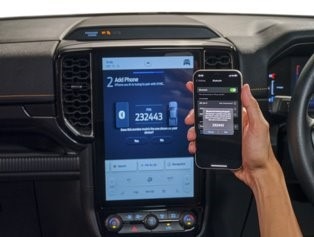
Ranger offers Emergency Assistance7 . If an accident results in an attempt to deploy an airbag, excluding knee airbags, or to shut off the fuel pump, your vehicle can contact emergency services by dialling the emergency number through a paired and connected Bluetooth-enabled phone. Emergency assistance can be switched on or off. Before making the call:
If you do not cancel the call, and SYNC® 4A makes a successful call, a pre-recorded message plays for the Emergency operator, and then the occupant in your vehicle is able to talk with the operator. Be prepared to provide your name, phone number and location immediately, because not all Emergency systems are capable of receiving this information electronically.
1. Rain Sensing Windscreen Wipers standard on XLT, Sport, Wildtrak and Raptor models only. Not availalable on XL or XLS models.
2. Tyre Pressure Monitoring System standard on XLT, Sport, Wildtrak and Raptor models only. Not availalable on XL or XLS models.
3. 360 Degree Camera standard on Wildtrak and Raptor. Optional as part of a pack at additional cost on XLT 4x4 and Sport Pick-Up models. Not available on XL, XLS or XLT 4x2 or XLT Chassis Cab.
4. Pre-collision Assist with Automatic Emergency Braking detects pedestrians, but not in all conditions, and can help avoid or reduce a collision. It does not replace safe driving. See Owner’s Manual for Limitations.
5. Driver-assist features are supplemental and do not replace the driver’s attention, judgment and need to control the vehicle. May not operate at certain speeds, or in certain driving, road or weather conditions. See Owner’s Manual for more information.
6. Some drive modes available on 4x4 only. Drive modes not available on XL models. Rotary dial to change drive modes is standard on Sport, Wildtrak and Raptor models only. A push button to change drive modes is standard for XLS & XLT models.
7. Emergency Assistance feature needs a paired and in range mobile phone. Can activate in the event of a crash which deploys an airbag or activates the fuel pump shut off.
8. Use of FordPass is subject to the FordPass Terms and Privacy Policy available on ford.com.au/fordpass and requires a compatible mobile device, internet access and software (including software updates from time to time). FordPass functionality and appearance may change over time due to software updates. You are responsible for internet access, mobile network data and voice call services required for your use of the FordPass App on your mobile device, including associated fees. The FordPass App and FordPass Connect modem can only work when both are connected to the telecommunications network. The FordPass Connect modem will only function on the 3G or 4G telecommunications networks. When these networks are no longer available, the modem will stop functioning and the connected services and all data transmission via the modem will cease. Ford cannot guarantee that FordPass will be in fully operating condition at all times and the FordPass App may be unavailable or particular FordPass services interrupted. Ford is not responsible for any limitations or restrictions of the telecommunications network or of your mobile device. Warning: Local laws prohibit some phone functions while driving. Check your local road rules before using these functions. Use Remote Vehicle Start and Stop responsibly and only in deskwell ventilated areas where you are aware of your vehicle’s surroundings.
9. Don’t drive distracted. Use voice operated systems where possible and don’t use handheld devices while driving. Some features may be locked out while the vehicle is in gear. Not all SYNC features are compatible with all phones. SYNC screen appearance and functionality may change over time due to software updates.


